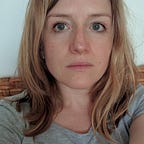Spooky action at a distance
‘Can you give a simple explanation of entanglement?’ is one of the first questions I’m asked at book events. Happily, I have a ready-made response for this one, recalling the celebrated physicist Carlo Rovelli on Desert Island Discs who, when asked the same question, laughed and said ‘no’. It is, he said, impossible to explain simply in language. It is a concept best understood within the realm of mathematics, rather than with metaphor or example. And if Carlo can’t, then no-one can.
My fascination with entanglement and quantum physics comes from the way in which it stretches the borders of our understanding and insists upon the need to embrace uncertainty. The famous example of Schrodinger’s cat introduces the notion of superposition — the quality of existing in all potential states at once. Of course, our experience of reality is not like this — we are in one place at one time — or at least appear to be. And yet, the numbers work, which is why, despite a lack of narrative proof, there is a school of thought in physics that adheres to the simple ethos: shut up and calculate.
On a literary level, though, there is something believable about the collection of particles only taking a coherent form of ‘dead cat’ or ‘living cat’ in relation to an observer. (Also, Schrodinger in one of his letters to Einstein described the unobserved cat as being ‘smeared about in equal parts’, which you have to admit has a gothic ring to it.) Observation is how we give the universe its form — we direct our observation into meaning, our stories into values, our responses and behaviours into a self. Unobserved, I move and even think in an entirely different way to when I am in company. When I am with my children I behave another way, and another way again with my parents. And yet, at any moment I am all of these people — writer, woman, mother, daughter, wife. Considering Schrodinger’s cat as a metaphor we might assume, therefore, that there is in fact no singular, unified self — merely a collection of behaviours that become ‘me’ or ‘you’ when seen through the eyes or told in the words of another. But, even if this were something we could comprehensively prove or disprove, it is mind-jammingly impossible to contemplate for too long — we just have to accept we don’t know and get on with living. We just have to shut up and breathe. In the story of Entanglement there’s a part where one of the characters, John, has encountered a life-altering illness. As his wife sits beside him, afraid about whether he will be the same person when he recovers, she manages in just this way: ‘Just this breath’, she says, ‘and then the next’.
Superposition and other concepts such as complementarity, duality and the uncertainty principle evoke in my mind a kind of dance-step diagram of the complex social experience of being alive. That is why quantum entanglement feels like an endlessly rich seam to explore in writing — even if I’ve never managed a simple paragraph or turn of phrase to sum the idea up. I wanted to take these ideas and use them as pattern cutters for a story. The hackneyed trope of entanglement as a metaphor for undying love is not one I endorse — but the notion of entangled particles exerting an instantaneous and opposite reaction in one another is an exciting prism through which to view characters and human stories. Moreover, to imagine a city as a quantum system, a place in which uncertainty must be written into any attempt to understand it, is tantalisingly true in its complexity and mystery. In Entanglement I wanted to understand London in this way — as a system that exists only in relation to itself, through the particles that move within it, and which, in order to survive, its characters must embrace the unknown and the misunderstood.
Einstein was infuriated by quantum entanglement, unable to disprove the apparently instantaneous communication between two particles that breaks the laws of relativity by traveling faster than the speed of light. He died without resolution, frustrated by this ‘spooky action at distance’ that he had never managed to explain. I wanted Entanglement to embrace not-knowing, because I believe that some things are unknowable and accepting this should be part of how we understand the world, as in Hamlet’s famous line: ‘There are more things in heaven and earth/Than are dreamt of in your philosophy, Horatio.’ The appreciation of our own smallness is a remarkably liberating condition. And although there is, in accepting such limitations, a risk that we might let ourselves off the hook in terms of our responsibilities to others, this isn’t the necessary outcome. Accepting that in our own lifetime there are many things we will not understand frees us up to act within the parameters that we do understand. We must shift our values from ‘being right’ to ‘behaving right’. Instead of striving for mastery, we can strive instead for compassion.
Recently, someone asked me how I married the ‘hard science’ with the ‘softer side’ of the characters’ stories. It was a great question, not least because it hit upon one of my favourite themes: the tension between scientific understanding of the world and the world as it is experienced day-to-day. But I’ve never really seen the division as hard vs soft. It is more a kind of call and response from one area of understanding to another, with art and literature as the membrane through which these different types of knowledge can pass and return. It is through this interplay of thought and the acceptance of doubt that we can enrich human understanding and move ultimately towards a more tolerant and compassionate reality. Even if we never get our heads around how exactly that reality works.
